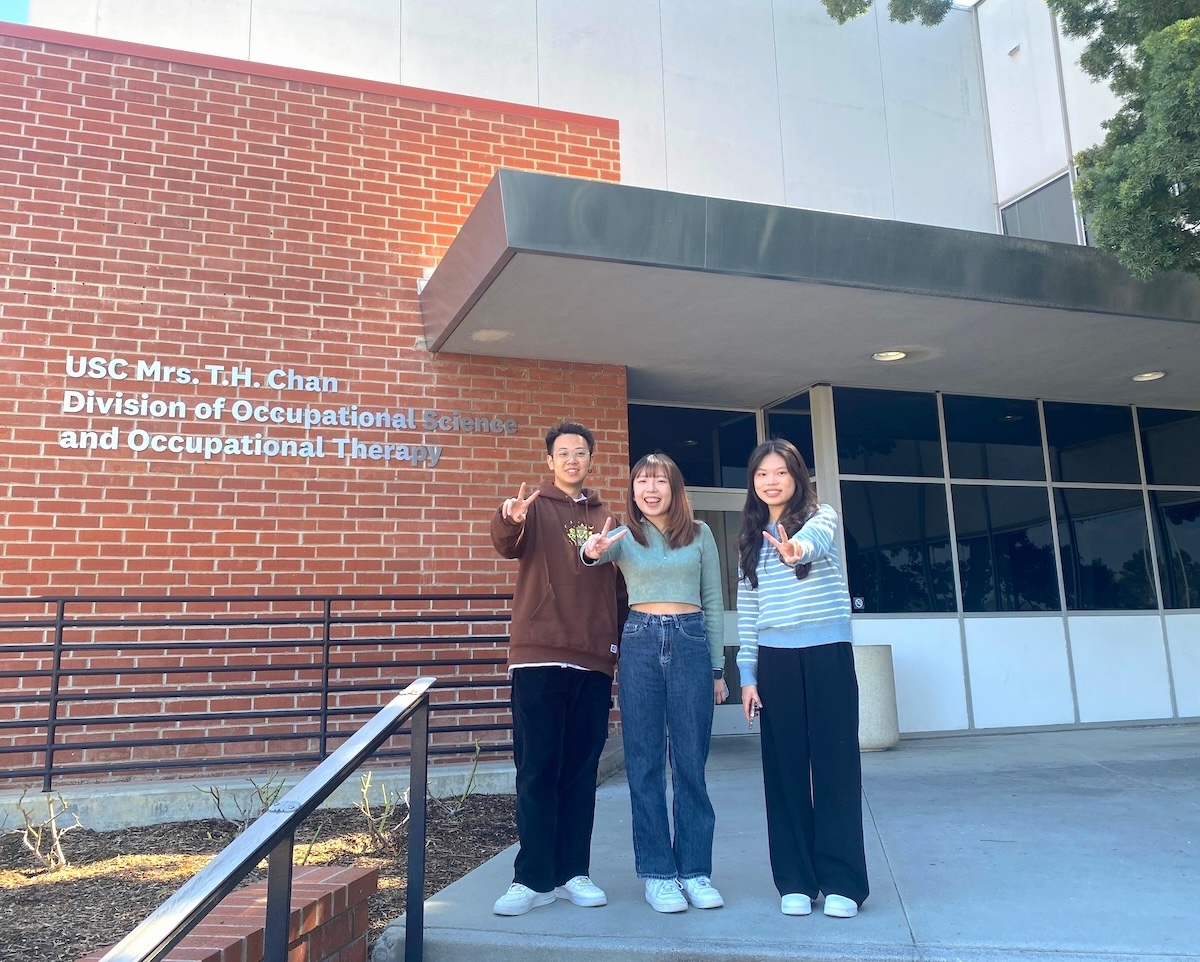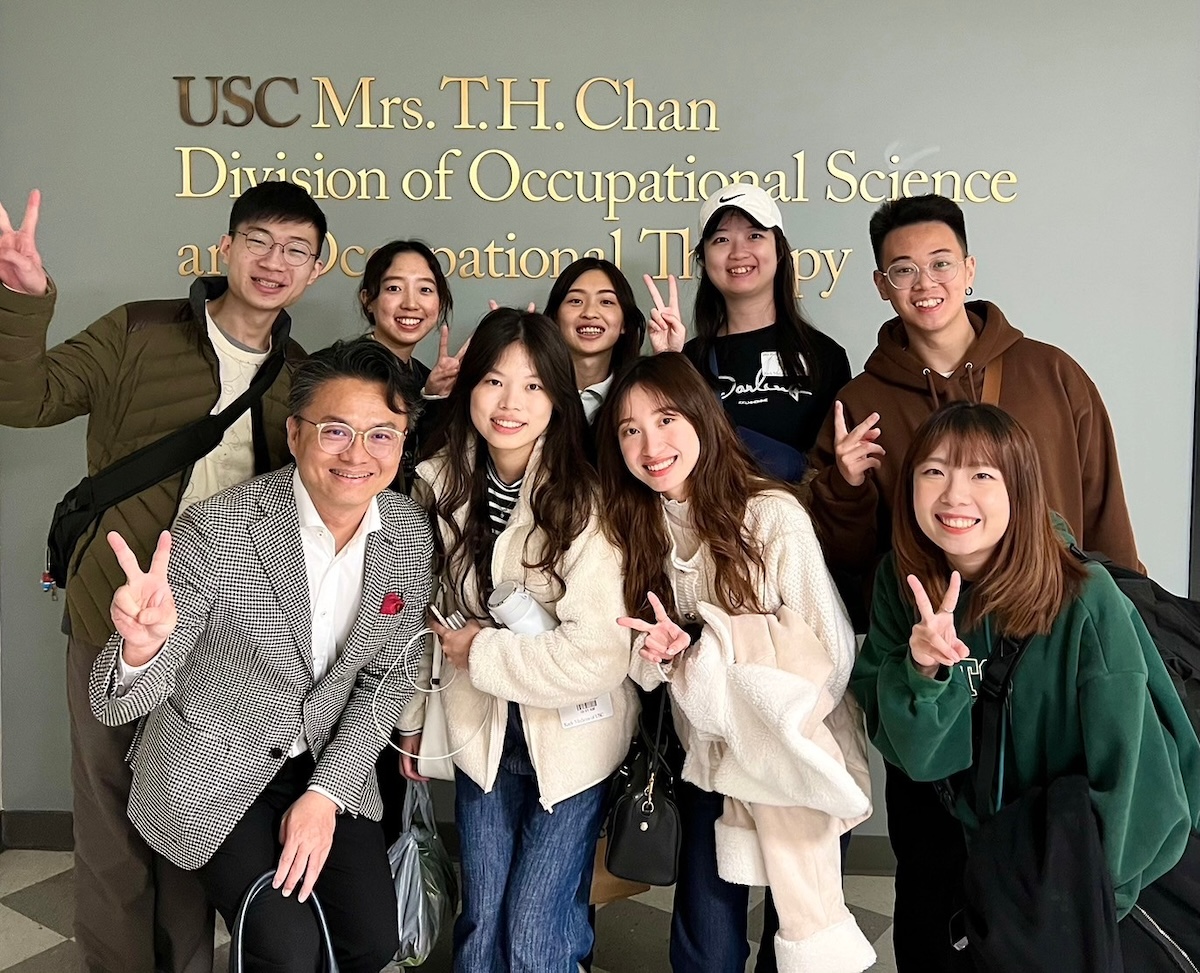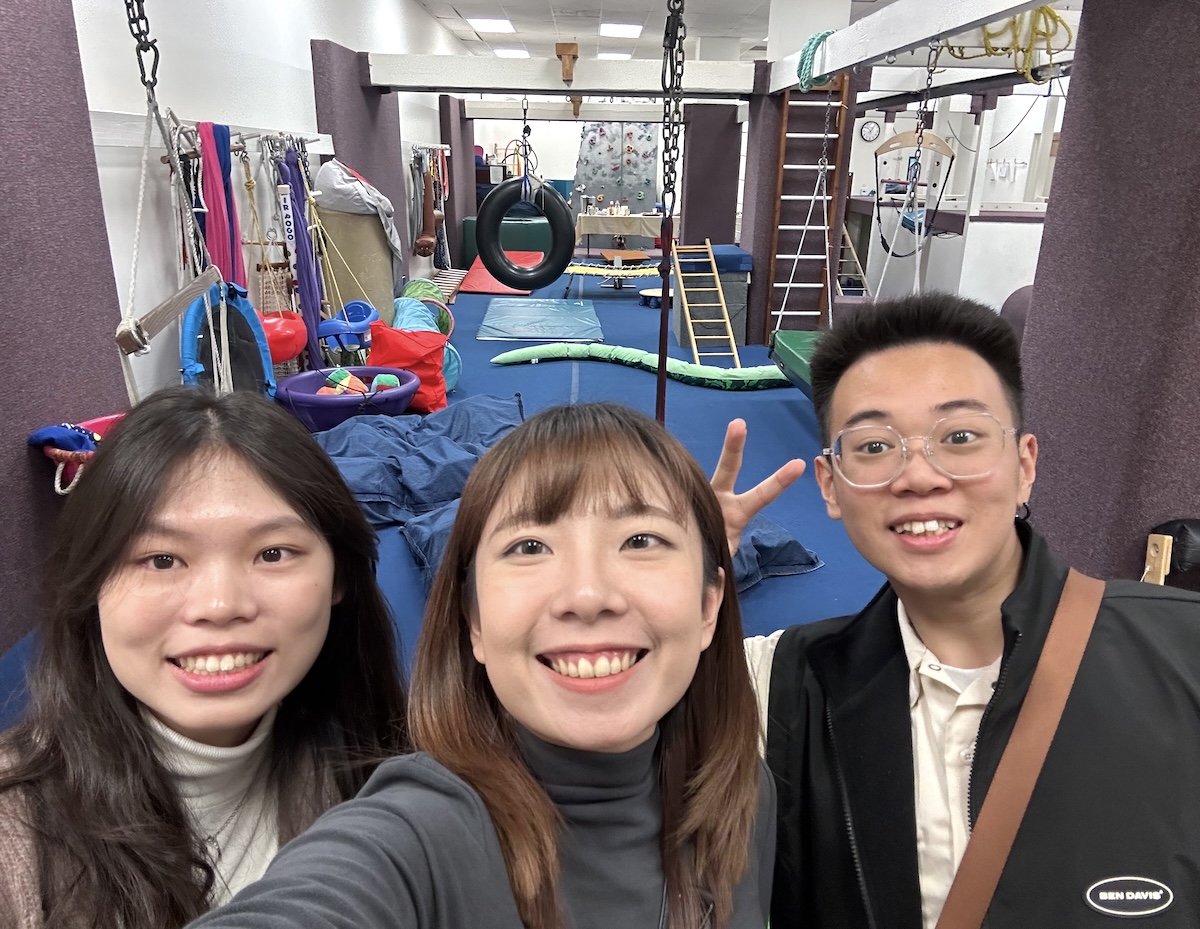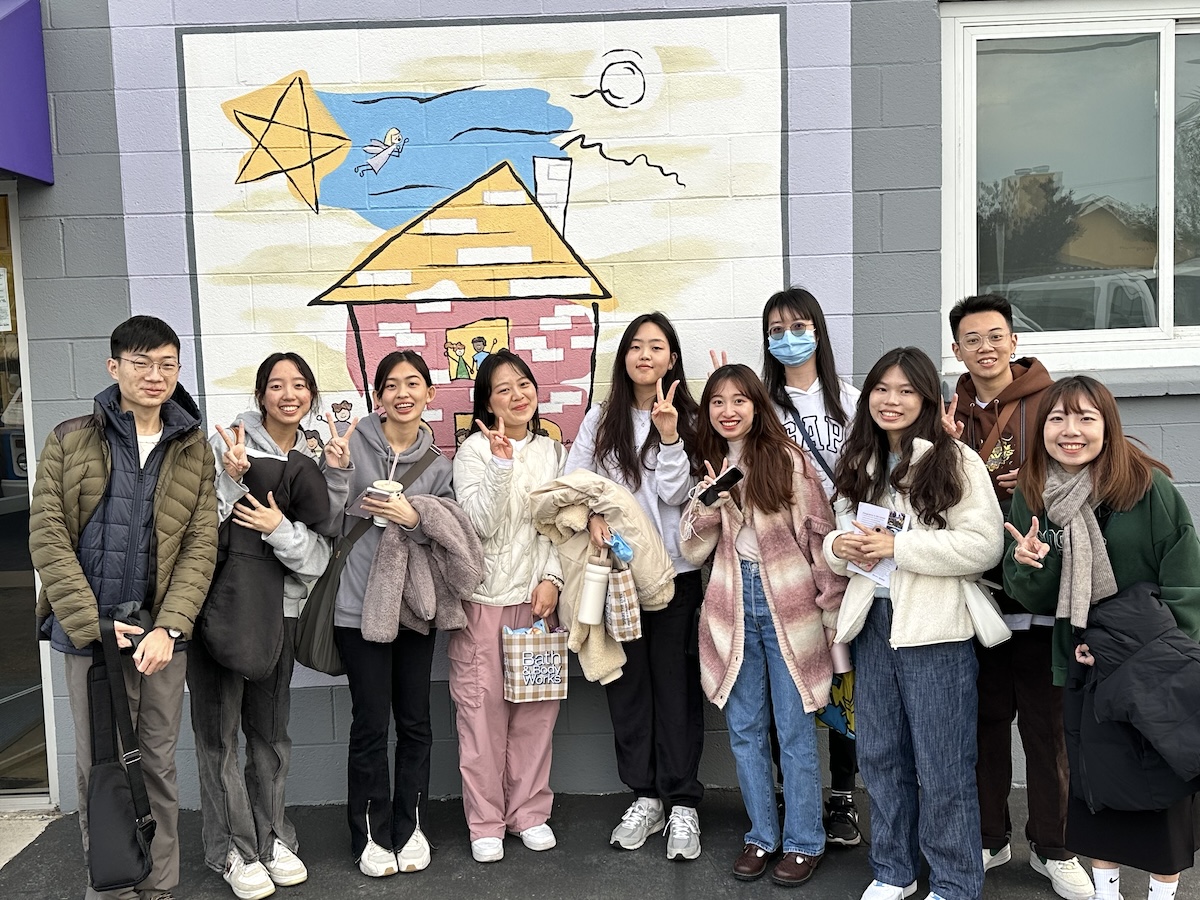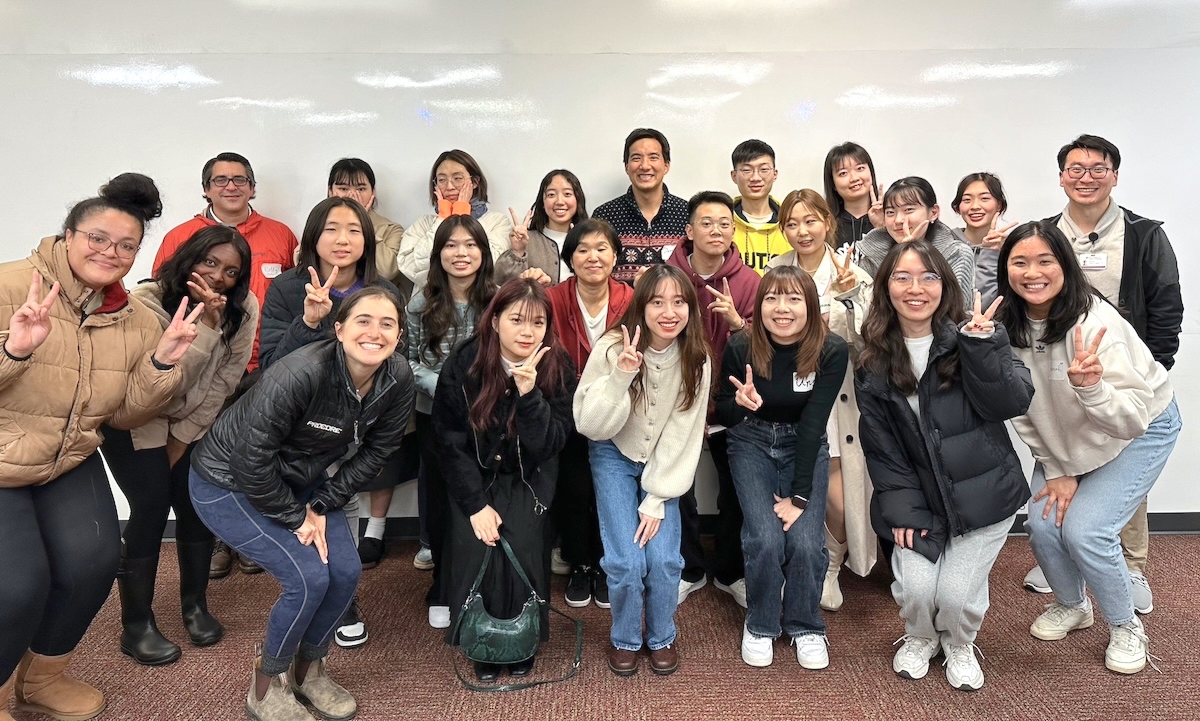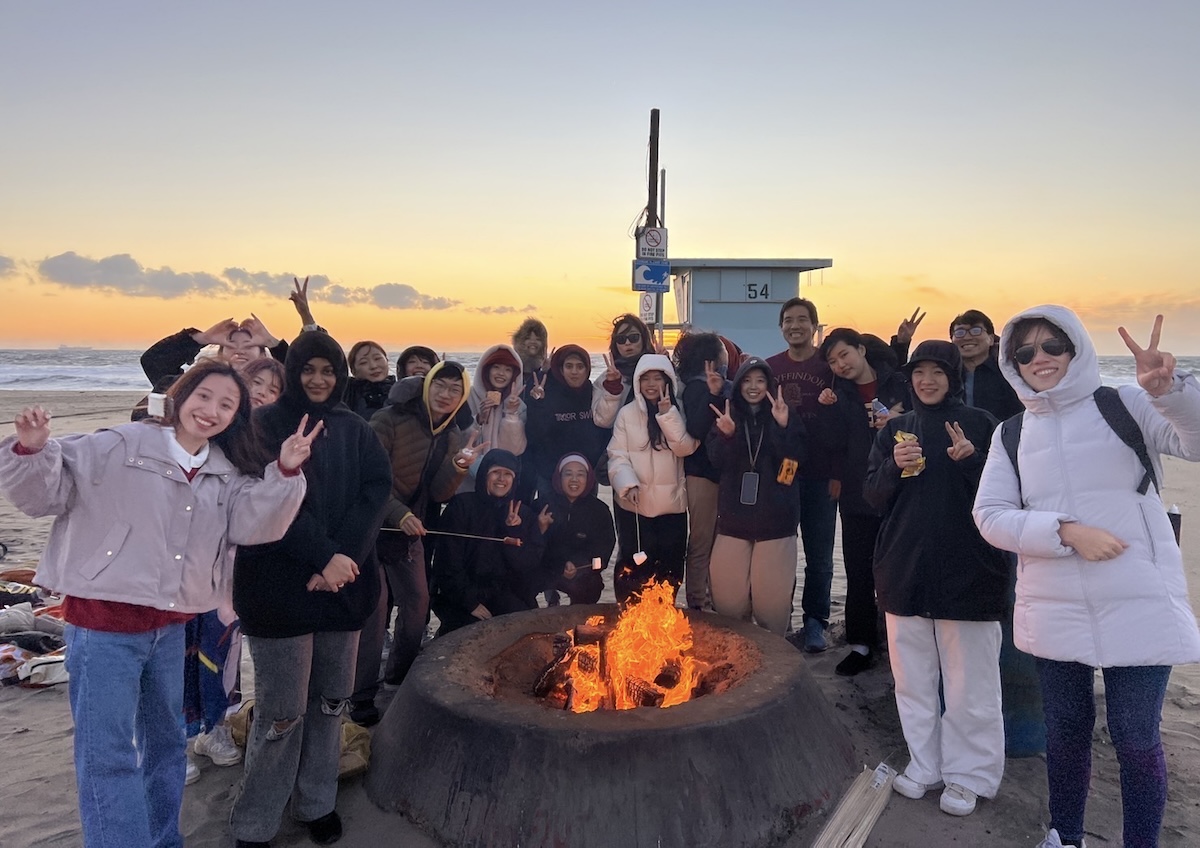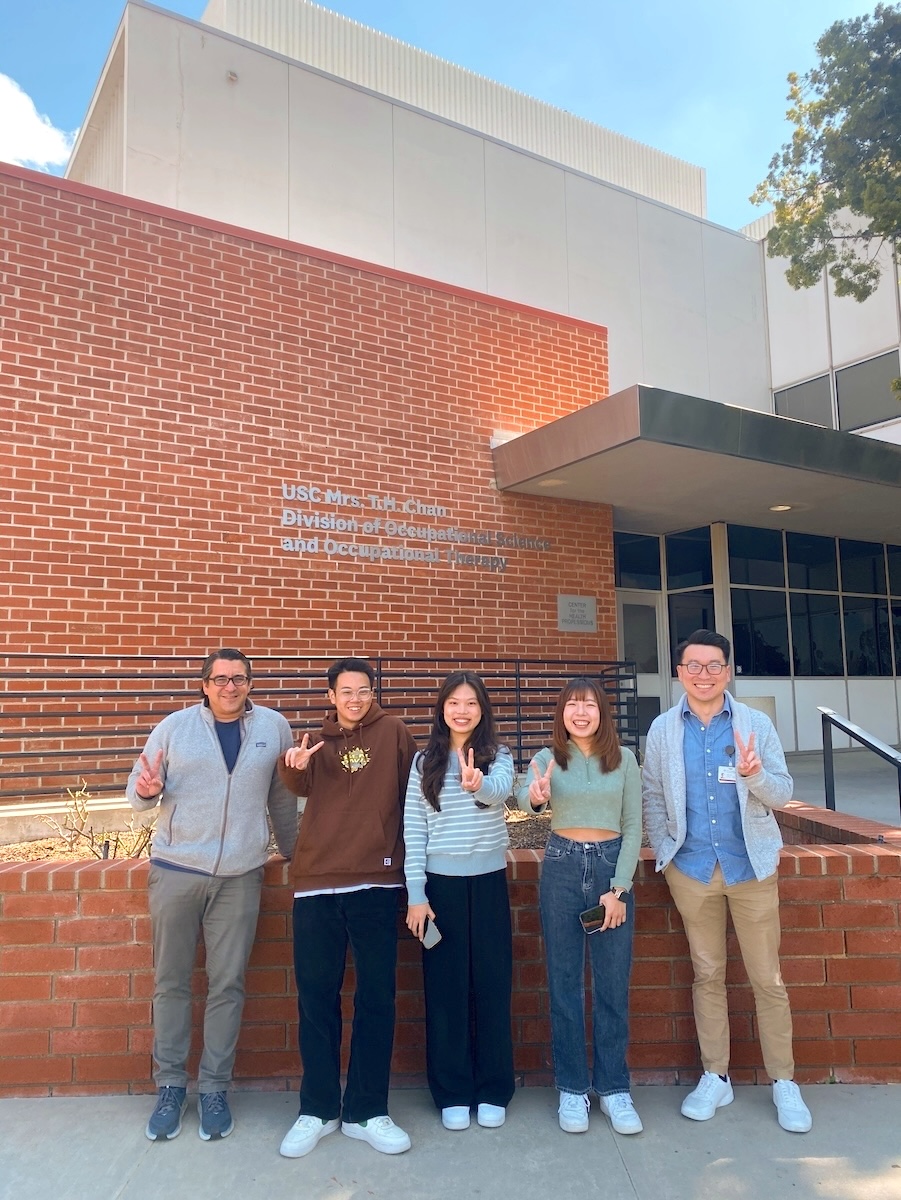Student Blog
Too Fun To Go Back Home!!!! ⟩
March 4, 2024, by Global Initiatives Team
By Jenny Yi-Chen Lu, Una Yu-Chen Tsai, John Yuan-Zhen Zhang
Edited by Princesse De Rossignol, 2nd-year E-OTD Student, and Xiaorong Wang, 1st-year E-OTD Student
We are undergraduate OT students from Kaohsiung Medical University, Taiwan. We’re here at USC for a five week exchange program to get to know more about OT and observe how they treat their patients clinically in America. During these five weeks, besides joining the class, we also had such a great time hanging out with the students here and those from Korea.
During this one month, we had some lessons, such as, motor control, sensory integration, Lifestyle Redesign® and more. Among all the lessons, the most impressive thing for us is the way professors teach and the students interact. Specifically, during the motor control class, the professor invited the stroke patients as a demo. During the class, the professors showed students how to stretch the tight muscles. That is a totally new experience for us to learn. On the other hand, most of the students are so active in asking questions and doing group discussion in the classes. Compared to here, the way we have our classes in Taiwan is more lecture-based. Honestly, most of the things that happen here help us expand our vision.
We also did some site visits and learned many different approaches to make the clients feel better and achieve their well-being. Some examples are hippotherapy and animal assisted therapy in Children’s Ranch, and the PECK model in Kensington Sierra Madre. After these visits, we got to know how the therapist here actually treats their patient with “occupation-based” ways. We appreciate this special opportunity we have, because during this month, we have seen the difference between the US and what we do in Taiwan in clinical practice. We believe that we still have a lot of room for improvement in how we can provide service to our clients.
Beside attending classes and site visits, we also participate in lots of social events with USC students and the Korean visitors. We had so much fun at the welcome party, chatting with each other and having delicious food. Thanks to the Global Initiatives team, we had the chance to walk around in Old Town Pasadena. We visited the ice cream shop there, and looked at the American style shops, creating unforgettable memories together.
At the end of the visit, we had our goodbye party on the beach. It was really cool to set up a camping fire on the beach, and we also had our first ever s’mores in life. We enjoyed a cozy and relaxing atmosphere by the seashore and took lots of photos with friends before we part ways. It is the most amazing experience that we have ever had.
Overall, the exchange program has allowed us to expand our global vision about occupational therapy and experience so many great things, including new friendships and amazing views in California. We have learned the differences between what OTs do in their countries internationally and these make us start to think about how to improve the medical environment in Taiwan to be more “occupational”.
⋯
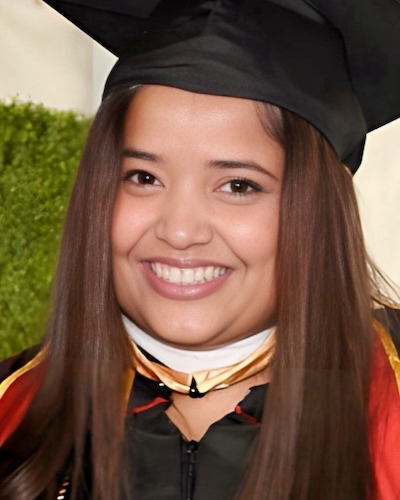
Pedagogy and Passion ⟩
February 27, 2024, by Sheryl
I remember my nerves as I stood in front of a class full of eager and unfamiliar faces for the first time as a pedagogy resident to present a portion of the class that I had enthusiastically signed up for. The topic, ironically, was explaining the Zones of Regulation which is a social-emotional learning curriculum using coloured zones to represent feelings or emotions like blue for feelings of sadness or boredom, green for happiness, calm and pride and red for terrified, panic or elation etc. Oh boy was I feeling RED!
As I began explaining the topic, adding my stories and experiences from working as an OT back in India and solving the case study with the class, I felt comfortable and at ease. I felt myself moving to another coloured zone. After my bit, I remember my preceptor gleamingly saying ‘You look as though you belong there, the students love you and find you very relatable’. Looking back now, I think that I was in the green zone. As I delve into my experiences, reflections, and the invaluable lessons I’ve learned along the way as a pedagogy resident here at Chan, my inner child is ecstatic and so grateful.
My mum, who has been a teacher for her whole life, often says that teaching is in my blood and takes full credit for this. There’s a profound truth to what she says because growing up in an environment where education was not just a profession but a way of life, I couldn’t help but be inspired by the passion, dedication, and unwavering commitment to nurturing young minds. While she may take full credit for this, her influence on me transcends mere conscious awareness — it’s a deeply ingrained part of who I am and how I perceive the world.
From the earliest days of my childhood, I was surrounded by the echoes of her and her teacher friends’ classroom tales. Through her actions, she taught me the value of patience, empathy, and resilience — qualities that are indispensable for anyone aspiring to become an educator. Yet, it wasn’t just her overt acts of teaching or the very strong influences of my own teachers that left an impression on me; it was the subtle nuances, the everyday interactions, and the unspoken lessons that shaped my understanding of what it means to inspire and empower others.
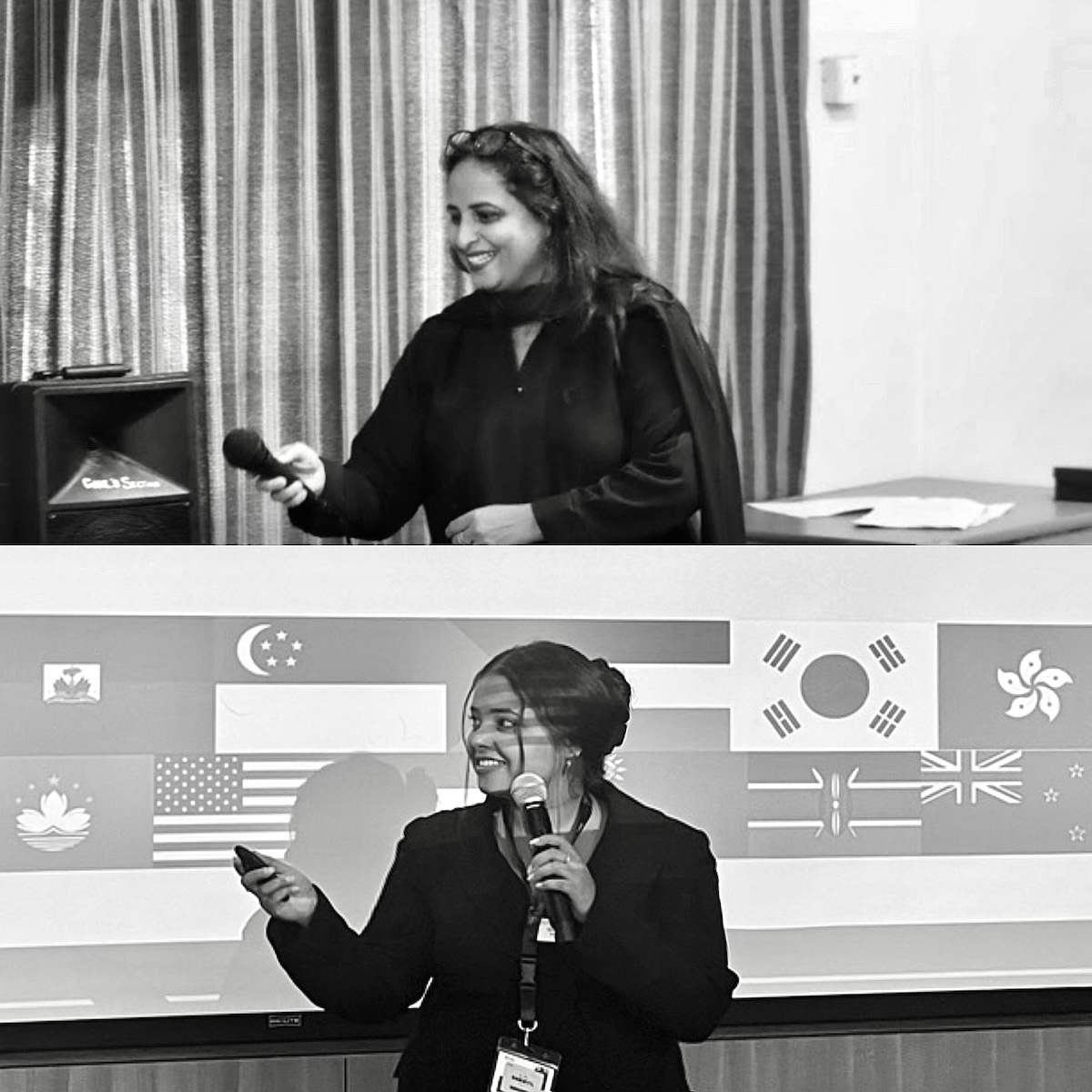
Pictured here: My mom and I in our elements, photographed 10 years apart.
From the outset, my residency at USC Chan was driven by this deep-seated passion for education and academia. I firmly believe that teaching is not merely a profession but a calling — a conduit through which we empower others to realize their full potential. At USC Chan, this ethos is palpable, permeating every aspect of the division’s pedagogical approach. One of the most striking aspects of my residency was the emphasis on collaborative learning where educators, students, and practitioners converge to exchange ideas, challenge assumptions, and co-create innovative teaching methodologies. Whether through faculty meetings, seminars, my faculty mentors, or small group discussions, I found myself constantly enriched by the collective wisdom of my peers.
Throughout my residency, I was challenged to reflect on my teaching methodologies, solicit feedback from students and teaching teams, and iterate upon my approaches in pursuit of continuous improvement. In doing so, I not only refined my pedagogical techniques but also deepened my understanding of the transformative power of education. I had a newfound appreciation and regard for the subtlety of labor that goes into curriculum development, classroom management and lectures.
I am filled with gratitude for the myriad experiences, challenges, and insights that have shaped my growth as an educator. From collaborative learning environments to inclusive pedagogical practices, from experiential learning opportunities to reflective practice, from nerves to knowledge, each facet of my residency continues to leave an indelible mark on my professional journey. I continue to embrace the lessons learned and nurture the belief that education, like occupation, is not merely a means to an end but a quest of discovery, empowerment, and transformation.
⋯
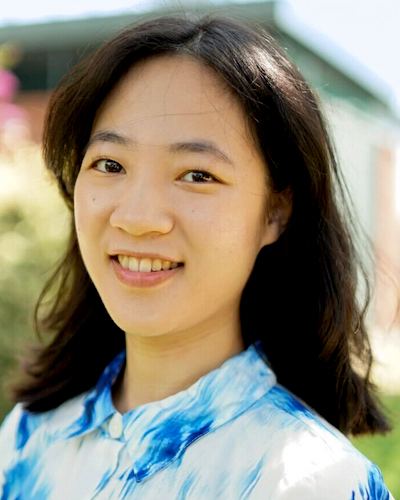
Lunar New Year Away from Home ⟩
February 26, 2024, by Cindy
Speaking of the New Year, the first thing that came to my mind is not January first but the Lunar New Year. It is not the end of the Christmas break, but the holiday week takes place roughly at the end of January and the start of February. This year, the Lunar New Year is a time for reconstructing meaningful rituals.
I came from a not-so-traditional Taiwanese household. I did not go to temples to ask for blessings for my family in the coming year and watch the dragon and lion dances. I did not set off firecrackers with my family at midnight. On Lunar New Year’s Eve, I did not have a traditional Lunar New Year dinner, a feast of numerous dishes that have meanings and blessings. I did not need to visit my mother’s family strictly on the second day of the Lunar New Year. I did not have so many relatives and friends of our family that we needed to visit and wish them a happy new year with witty haikus to get red envelopes.
Although my Lunar New Year celebration does not have all the Chinese and Taiwanese customs, I have always spent this time with my parents and brother. Always. We would have a hotpot as our Lunar New Year dinner at my grandma’s place. We would play mahjong (麻將) while watching the Lunar New Year gala on TV. We would complain about listening to Lunar New Year songs on repeat everywhere we go. We would go camping, go to the movies, go hiking, etc. It was a week when we were all home and spent this blissful time together.
I have never realized the meaning of the Lunar New Year in my life until this year. I am not in Taiwan with my family anymore. As I approached February tenth, the grief of loss started lurking in. I kept searching for the scenes I used to overlook: red lanterns and spring couplets at every door, random firecrackers in the middle of the night, people cleaning their windows in the yard, old furniture sitting in the lobby of the building waiting to be picked up by recycling trucks, and candies stacked in plastic boxes on sale at hypermarkets. I miss the smiles on people’s faces when they greet each other with “新年快樂 (Happy New Year)” and “恭喜發財 (Wish you prosperity and wealth).” Happiness flowed through every corner. The atmosphere is radiating red and gold. It was so joyous that the time paused and celebrated with us.
My tears sat with me, recalling those memories in the peaceful atmosphere of LA. The atmosphere was so quiet, as if time disappeared. At that moment, I realized the significance of the Lunar New Year in my life. I knew I needed to celebrate the Lunar New Year in new but meaningful ways.
On the day before New Year’s Eve, the Global Initiatives Office celebrated the Lunar New Year just like they would celebrate festivals from different cultures. The Global Initiatives Office prepared tangyuan (湯圓), oranges, and red envelopes. In addition, all my Taiwanese classmates came to our house and had the Lunar New Year dinner that night. We ordered soup base, sliced meat, meatballs, and vegetables online to make a hotpot. Everyone brought Taiwanese cuisine to share: candied fruit, rice wine drunken chicken, and Taiwanese cookies. We cooked the hotpot and ate at the same table. We shared all the interesting clinical experiences we had. We played mahjong on our phones. We ate together, laughed together, and missed our Lunar New Year rituals together. When I said goodbye to everyone at 12:30am, I thought with a big smile: “This feels like Lunar New Year.”
I learned that celebrating festivals is an integral part of my identity. Those festivals are my culture, values, and how I measure a year. In addition, the festival celebrations in my life are memories that shaped me, representation of social connections, and a part of my life narrative. I am so glad that in Los Angeles, at USC Chan, it is not hard to find people with the same cultural background as mine. I am also grateful that the Chan division put in so much effort to celebrate festivals valued by different groups of people. Celebrating our festivals gives us a chance to be seen and accepted. In this new year, I can try to maintain and reconstruct my festival celebration rituals and make them as meaningful as I have enjoyed them.
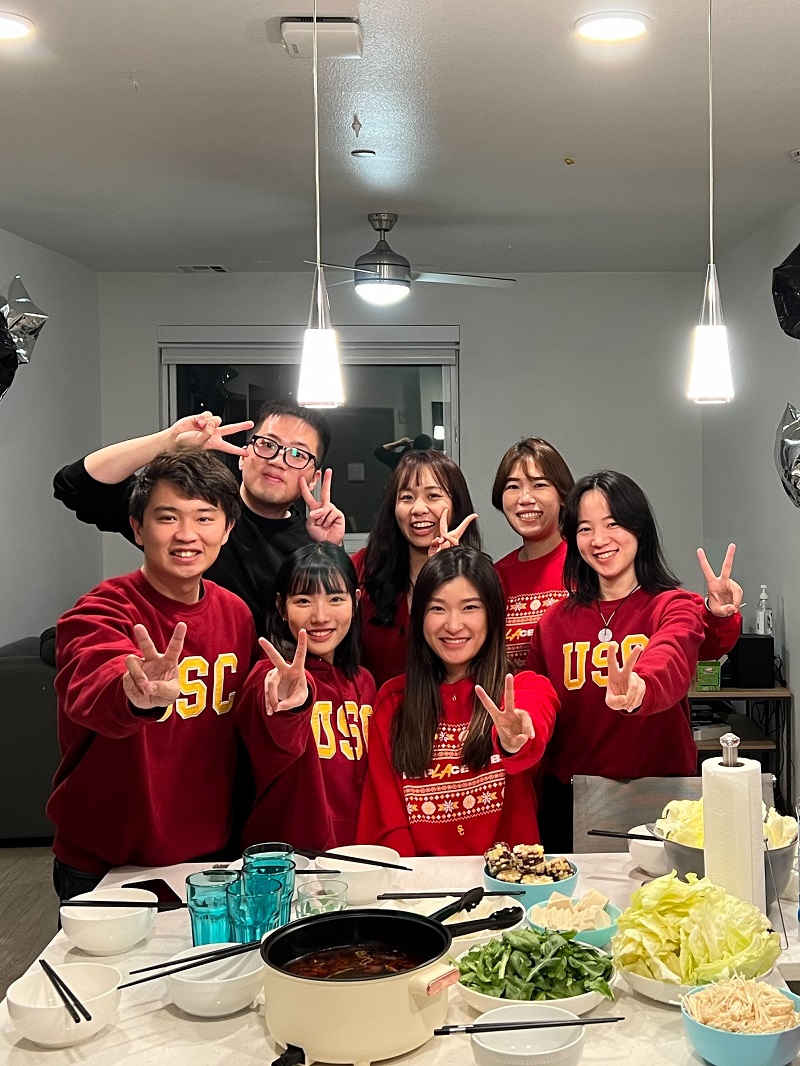
My Taiwanese classmates and me having a hotpot
⋯

In the words of Elle Woods, “What? Like it’s Hard?” ⟩
February 15, 2024, by Natalie
GRADUATE SCHOOL. Sounds scary doesn’t it? Being a first-generation student, I struggled to create a mental picture of myself at undergrad, let alone at grad school — but I made it through undergrad. I had all the support from my family and friends and was raised being taught there isn’t anything that can get in my way, and that if it felt like there was, to persevere and create my own path. So that’s what I did. But what no one told me was that the application process would be even scarier.
The application process for OT school was overwhelming to me. I began researching programs and their application requirements in late 2018 but only applied in the 2021 application cycle. At the time, I noticed that almost, if not all, the schools required applications be submitted through OTCAS and also had their own program specific requirements. Some schools required applicants to submit a supplemental application or submit an application to the graduate school at their university, required additional volunteer hours, or needed supplemental forms. I can fill another 4 pages to talk more about MY specific application process adventure, but instead I want to give all of you some information and tips that I think would have been useful to know before starting the process.
- Start earlier than you expect to. In doing my research and trying to find advice on how to navigate the timeline for submitting applications, I found a really cool schedule that gave me a monthly overview of what to complete in that month in order to submit my applications with a month or two to spare. Even with the timeframe laid out for me, some of my steps took longer to complete and I found myself being happy with having more time.
- Triple check the due date. The programs I applied to required that my application be verified by the due date. OTCAS will handle the verification process for your application, but in order to ensure it gets verified in enough time to meet the deadline, you need to submit your application three weeks earlier. It is completely possible for an application to get verified within a few days, but why stress yourself out with something that is so out of your control?
- Organize the requirements for your different programs in a way that makes sense for you. Because having multiple programs with different requirements can be overwhelming, it can be super helpful to organize the requirements in a list, table, chart, etc. I made a list for myself for each program, but looking back, a Google sheet or Excel sheet would have been more fitting. Seeing all of the programs and the requirements organized but in one place can be helpful, and using the Google/Excel sheet allows you to strikethrough or highlight the completed cells.
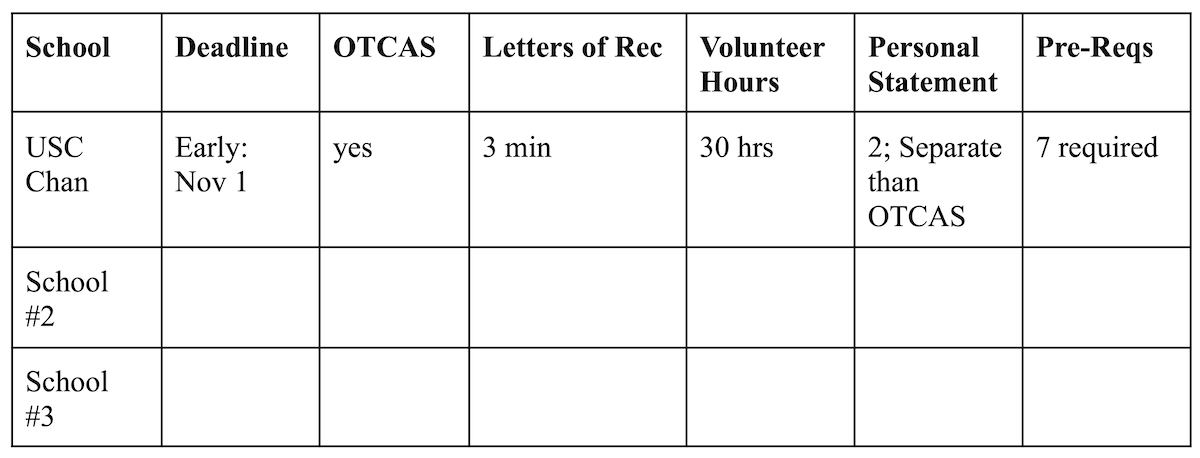
- Budget accordingly. Grad school applications can get expensive. OTCAS charges about $160 for the first program you apply to and around $70 for EACH additional program. On top of that, some schools have their own additional application fee. OTCAS does have a Fee Application Program which provides a waiver that covers the cost of the first program you apply to. (Note that these waivers are limited and come on a first come first serve basis.) Once you are accepted, many of the schools also require a deposit (not USC) to save your spot and those fees vary in price.
- Reach out to schools directly for help. It might feel a little daunting to reach out to a school to ask questions to clarify their requirements (especially if you are like me and overthink everything). Keep in mind, schools want you to apply to their programs. They want to hear from you, want to answer your questions, and want to do whatever they can to make this process easier for you. And no, they won’t be keeping track of the questions you ask or assessing you in every single interaction you have with them — if that were the case, that would be listed as an application requirement.
- Familiarize yourself with OTCAS. Most of the schools require applicants to submit their applications through the Occupational Therapy Centralized Application Service (OTCAS). Using OTCAS allows you to submit all of the requirements that overlap across the programs you plan to apply to, helps track your progress, and as I mentioned earlier, completes the verification process for you. As with anything new, it can be confusing to use without spending time to familiarize yourself with it first.
- Lean on your support system! I don’t need to tell you that your family and friends are there for you and want to see you succeed — that’s a given. But your support system is probably bigger than you realize — the OTs that you shadow, any mentors you have, they’re all there for you too and they have been through the application process before, giving them a specialized and extra relevant perspective.
- Be strategic with your personal statement. Most OT programs are working towards trying to diversify their student populations (yay!) and in doing so are looking for well rounded individuals. Sure your grades and past GPAs are important, but so are your personal statements, through which the admissions teams are getting to know YOU as a person. Furthermore, because OT is as holistic as it is, I believe there is an even greater importance in making sure your personality (and not just all your achievements) shines through your personal statement.
- Don’t underestimate yourself. To be fully transparent, I applied to USC Chan just for fun, and even worried I wouldn’t be accepted to any of my programs because of how long I had been out of school. Looking back, I can definitively say I applied to way too many programs and really should have had a bit more faith in myself. Now I can’t guarantee anything, but if you’re spending your time reading blogs like this to better prepare for the process, I bet you are an amazing candidate and will make it to where you want to be.
This is a long list of suggestions and advice, I know. I hope it helps you channel your inner ✨Elle Woods✨ throughout your application process! Please do not hesitate to reach out to me or any of my fellow ambassadors at .(JavaScript must be enabled to view this email address) if you have any other questions. Best of luck and Fight On!
⋯
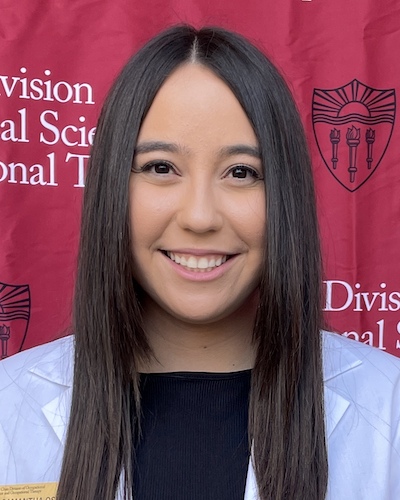
A Love Letter to OT ⟩
February 6, 2024, by Samantha
With February upon us, love is in the air and, as a bit of a hopeless romantic myself, I’ve been taking time to reflect on the things I love, including OT. Growing up, my parents always encouraged me to pursue my dreams and find a career that I was passionate about. My dad would say, “Sam, if you’re doing something you love, you’ll never work a day in your life.” Although I have yet to fully immerse myself in practice, every time I participate in fieldwork and envision the future I’m creating for myself in school, I’m confident that I love OT in the same way my dad describes loving his career. Upon reflection, here are some of the many reasons I fell in love with the profession of occupational therapy:
Playing with a Purpose: As a sophomore in high school, I was introduced to occupational therapy when my cousin, Tori, was born with Down Syndrome. In efforts to support my family and learn more about pediatric healthcare professions, I joined Tori at many of her PT, OT, and speech therapy sessions. It was here that I began to recognize the value of play as a means of therapeutic intervention. Whether it was running around on an obstacle course to work on balance and motor planning or swinging on a bolster swing to receive vestibular input, Tori was having fun while simultaneously strengthening skills that would be applicable to other facets of her life. Through my observations in this OT clinic, I fell in love with the concept of playing with a purpose and knew I could see myself making a difference in children’s lives in this manner for the rest of my life.
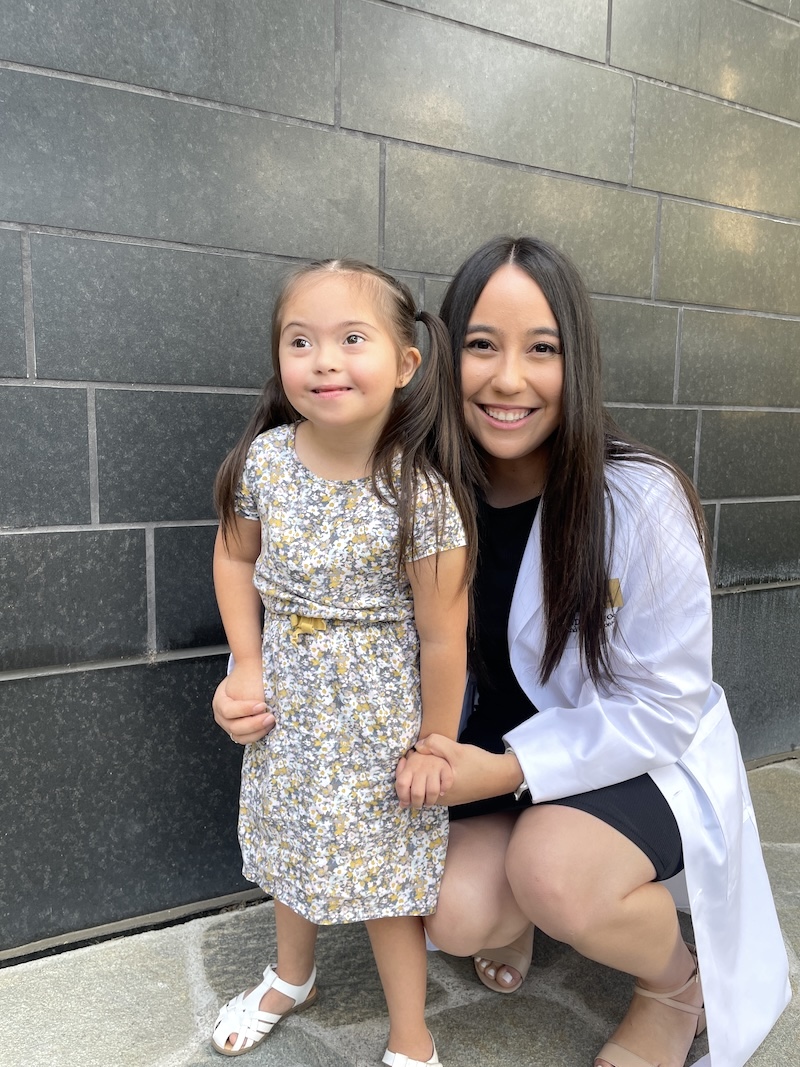
Me and Tori at my White Coat Ceremony in 2022!
Flexibility in Practice Areas: Like many, I arrived at OT school with my heart set on pediatrics. As I began my first immersion, I was placed at an outpatient hand therapy clinic for fieldwork and became enamored with the complexities and inner workings of the hand and wrist. Internally, I began having a bit of an identity crisis, as I was unsure of the definitive path I wanted to pursue. However, my perspective shifted when I recognized the flexibility within the field of OT. Although certain settings require advanced practice, there’s a beauty to the inherent flexibility that this profession offers. OT practitioners have the freedom to navigate through various practice areas at different points in their lives. For instance, starting an entry-level position in acute care doesn’t confine someone to that setting forever. If this same individual desires to start a family or becomes the primary caregiver of a loved one later in life, transitioning seamlessly to a more suitable practice area without returning to school is a viable option. Ultimately, I love that the dynamic nature & flexibility of occupational therapy not only promotes the practitioners’ ability to enhance the lives of others, but also empowers them to pursue a career that aligns with their evolving personal and professional aspirations.
Applications of Creativity: As a creative person who enjoys crafting and making music, I love having the opportunity to integrate these aspects of my own life into professional practice. In our Creativity, Craft, and Activity Analysis course, we explored different creative modalities that can be used to enhance interventions with clients. From collaging a vision board to promote self-awareness and identity to making a pumpkin out of construction paper to practice cutting with scissors, the possibilities are endless. The creative process allows people to explore and express themselves in ways that traditional interventions might not achieve, therefore being creative in my personal life informs my practice. Although this application can be challenging at times, I find it exciting to be able to integrate occupations I enjoy in my profession.
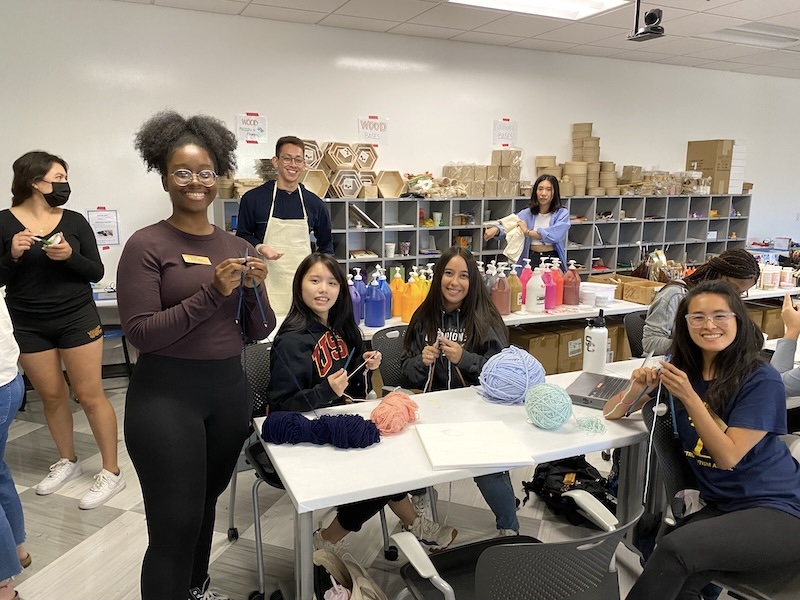
Me and my classmates knitting in the Creativity, Craft, and Activity Analysis course
Though everyone’s occupational therapy journey is different, I hope that my experience and love for the profession helps you appreciate it & ponder the reasons you’re pursuing this career too.
⋯






